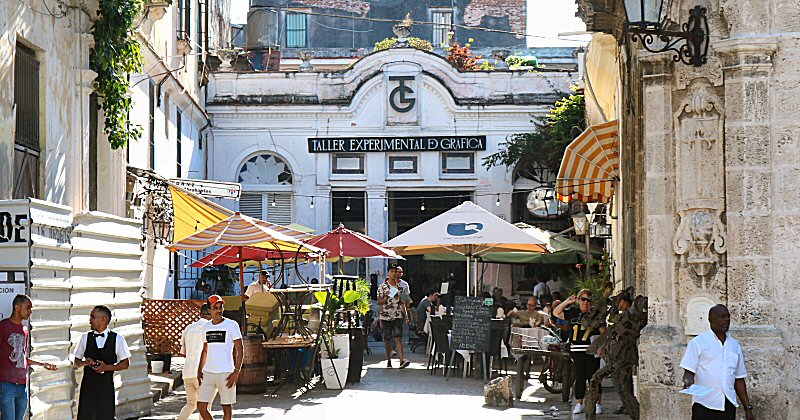
The Taller Experimental de
Gráfica is located at the end of the cul-de-sac #62 (former
#22), called Callejón del Chorro, on the southwest corner of the
Plaza de la Catedral.
The Taller
Experimental de Gráfica is specialized in lithographs
produced by traditional printing technique.
Lithography is a method of printing based
on immiscibility of oil and water. Lithos means stone in
Greek language. This technique was invented by the German
author and actor Alois Senefelder in 1796 to publish the
theatrical works in a cheap way.
In lithography the image is drawn on a smooth surface of the stone, using a grease-based material like oil, fat or wax that are pigmented to make the drawing visible. Then the stone is treated with a mixture of acid and gum arabic. This would etch the portions of the stone that are not protected by grease. Subsequently, the stone is moistened, so that the etched areas retain water. When an oil-based ink would be applied on the stone, it would only stick to the areas corresponding to the drawing, as they have been treated previously by a grease-based material, while in the rest the ink would be repelled by the water. Thus, the wet image can be printed on a blank paper sheet by using a cylinder press.
The type of the stone used in lithography, should have special features; it must be sufficiently porous to be able to absorb the water, and at the same time, it must have a very fine granular structure, so that it can retain the grease-based material. The calcareous stone, like the limestone, is the most convenient stone for this method of printing.
The great difficulty to find the suitable
calcareous stone and its high cost, led to use zinc plates
that have the advantage of being manufactured as large as
desired. Furthermore, it is easy to handle with metal plates
and to store them. Thus, lithography constituted the origin
of the modern offset printing techniques, but it is still
used in some fine art printmaking applications. It should be
also noted that lithography is not an engraving technique,
as the surface of the stone maintains its smooth surface
without any structural change.
Lithography was imported to Cuba from
Europe before other American countries. It was used in the
publicity works of the sugar and tobacco industry and the
tourism, as well as in the creation of stamps for the
Catholic church. The tobacco industry was the main customer
of the Compañía Litográfica de la Habana (Lithographic
Company of Havana; established in 1906) that was printing
the decorative advertisements, marquillas (labels) for the
snuffboxes and cigarette packs and the vitolas (ring-shaped
paper girdle that is placed on cigars to indicate their
characteristics and the brand or distinctive of the
manufacturer). The Spanish tobacco companies, like Partagas
and Romeo & Juliet, and the German tobacco companies like H.
Upman and Gustav Bock were using lithographic material
extensively. Gustav Bock is the first person that used
printed cigar bands as a branding and authentication method
for the cigars.
When the the Compañía Litográfica de la
Habana could not adopt to the newer techniques of the offset
printing and was closed, the stones used in lithographic
printing, were then mixed with the stones used to make
walking paths through muddy fields and trenches for military
exercises. During the Missile Crisis they were laid down
around the city to serve as barricades. The presses used to
transfer the picture from the stone to the paper, were
melted down to extract the metal inside.
A group of artists, including the Cuban
muralist Orlando Suarez (1926-1986), the
lithographs Amable Mouriñoe and Israel de la Hoya and
the Chilean painter José Venturelli
(1924-1988), made a joint attempt to avoid the destruction
of these artistic materials that have a rich history and to
rescue the remaining equipment of the Compañía
Litográfica de la Habana from the destruction. The communist
painter and lithographer José Venturelli
explained the situtation to his compatriot Pablo Neruda that
would visit Cuba in the near future. Pablo Neruda wrote a
letter to Che Guevara, the Minister of Industry and the
Chairman of the National Bank of Cuba, conveying the idea of
Venturelli to establish a graphic center to house the
recycled stones and the discarded printing machines of the
closed lithography company and to use them for artistıc
purpose, and asked a favor for the necessary permission of
the transfer. Che agreed, and thus, the Taller
Experimental de Gráfica was established in 1962.
In contrary to the use of the
lithographic painting at the disposal of the tobacco and
sugar industry in the past, the
Taller Experimental de Gráfica used it in developing purely
artistic projects. The artists, graduated from the workshop,
incorporated new creative techniques and procedures into the
traditional lithography.
At the beginning of the workshop the essential concern was to rescue the traditional lithography and to take forward it by adding new artists, as the workshop under the direction of the outstanding plastic artist José Manuel Contino Pérez (1932-2002; the director until his death) had no more than ten artists in those years. As the link between the growing Escuela Nacional de Arte (National Art School) and the Taller Experimental de Gráfica got stronger, the first graduates of the National Art School brought new ideas to the workshop. Most of the artists that form the current core of the workshop, belong to the enthusiasm in 1970s and 1980s. Eduardo Roca Salazar, Luis Miguel Valdés, José Gómez Fresquet, Nelson Domínguez Cedeño, Zaida del Río, Roberto Fabelo, José Omar Torres, Carlos del Toro Orihuela, Ángel Manuel Ramírez Roque, Diana Balboa were the most popular artists of the workshop.
